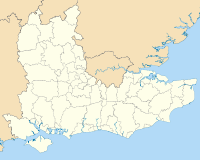Sevenoaks District
The district was formed on 1 April 1974 by the merger of Sevenoaks Urban District, Sevenoaks Rural District and part of Dartford Rural District.
Geography
The area is approximately evenly divided between buildings and infrastructure on the one hand and woodland or agricultural fields on the other. It contains the upper valley of the River Darenth and some headwaters of the River Eden.
The vast majority of the district is covered by the Metropolitan Green Belt.
In terms of districts, it borders Dartford to the north, Gravesham to the northeast, Tonbridge and Malling to the east, briefly Tunbridge Wells to the southeast. It also borders two which, equal to it, do not have borough status, the Wealden district of East Sussex to the south and the Tandridge district of Surrey to the southwest. It borders the London Boroughs of Bromley and Bexley to the northwest.
In the 2011 Census, the district had a population of 114,893.
Governance
Sevenoaks District Council | |
|---|---|
 | |
| Type | |
| Type | |
| Leadership | |
Pav Ramewal since 2013 | |
| Structure | |
| Seats | 54 councillors |
 | |
Political groups |
|
| Elections | |
Last election | 4 May 2023 |
Next election | 6 May 2027 |
| Meeting place | |
 | |
| Council Offices, Argyle Road, Sevenoaks, TN13 1HG | |
| Website | |
| www | |
Sevenoaks District Council provides district-level services. County-level services are provided by Kent County Council. The whole district is also covered by civil parishes, which form a third tier of local government.
In 2009 the Audit Commission named Sevenoaks District Council as one of the four best-run and most efficient councils in the country.
Political control
The first election to the council was held in 1973, initially operating as a shadow authority alongside the outgoing authorities before coming into its powers on 1 April 1974. Political control of the council since 1974 has been as follows:
| Party in control | Years | |
|---|---|---|
| Conservative | 1974–1995 | |
| No overall control | 1995–1999 | |
| Conservative | 1999–present | |
Leadership
The leaders of the council since 1999 have been:
| Councillor | Party | From | To | |
|---|---|---|---|---|
| Alison Cook | Conservative | 1999 | 10 May 2005 | |
| Peter Fleming | Conservative | 10 May 2005 | 7 May 2023 | |
| Julia Thornton | Conservative | 23 May 2023 | 14 May 2024 | |
| Roddy Hogarth | Conservative | 14 May 2024 | ||
Composition
Following the 2023 election the composition of the council was as follows:
| Party | Councillors | |
|---|---|---|
| Conservative | 33 | |
| Liberal Democrats | 14 | |
| Green | 4 | |
| Independent | 3 | |
| Total | 54 | |
Two of the independent councillors sit together as the "Sevenoaks Independents". The next election is due in 2027.
Elections
Since the last full review of boundaries in 2003 the council has comprised 54 councillors, representing 26 wards. Elections are held every four years.
Premises
The council is based at the Council Offices on Argyle Road. The offices were built for the council on the site of a large house which had served as the offices of one of the council's predecessors, the Sevenoaks Urban District Council. The new building was formally opened on 3 March 1986.
Housing and architecture

The layout of the district is dual-centred:
- A well-buffered suburban town itself, which spreads into suburban villages (St Johns, Riverhead, Dunton Green, Sevenoaks Weald).
- Swanley and smaller, equally buffered Hextable and Crockenhill within the M25 motorway.
In all areas low-rise dominates: the incidence of flats exceeding two storeys is rare.
The number of listed buildings in the district exceeds 150. This includes 16 churches listed in the highest grading in the national listing system (Grade I). Castles and English country houses of the wealthiest in society from the 16th to 18th centuries form part of this district.
Examples at Grade I include Knole House, Chartwell, Penshurst Place and Chevening House, most of which have their own produce-selling farms. Older with original stone walls are Hever Castle with its 16 acres (6.5 ha)-wooded island in a listed parkland. A folly exists at Lullingstone Castle which is a reconstruction of its gatehouse and separate modern house.
Towns and parishes
The whole district is covered by civil parishes. The parish councils for Sevenoaks and Swanley are styled as town councils.
|
See also
References
- ^ UK Census (2021). "2021 Census Area Profile – Sevenoaks Local Authority (E07000111)". Nomis. Office for National Statistics. Retrieved 5 January 2024.
- ^ District Council website
- ^ "2011 Census profile: Age and gender profile (unrounded)" (PDF). Kent County Council. Retrieved 28 March 2014.
- ^ "Council Chairman". Sevenoaks District Council. Retrieved 7 July 2024.
- ^ "The Council's new Leader and Cabinet". Sevenoaks District Council. 15 May 2024. Retrieved 7 July 2024.
- ^ "Council structure". Sevenoaks District Council. Retrieved 27 September 2023.
- ^ "Local Government Act 1972", legislation.gov.uk, The National Archives, 1972 c. 70, retrieved 31 May 2023
- ^ Sevenoaks District Council : 9 December 2009 : Sevenoaks Tops National Performance League Table Retrieved 22 August 2010
- ^ "Council minutes". Sevenoaks District Council. Retrieved 25 July 2022.
- ^ "Your Councillors". Sevenoaks District Council. Retrieved 27 September 2023.
- ^ "The District of Sevenoaks (Electoral Changes) Order 2001", legislation.gov.uk, The National Archives, SI 2001/3557, retrieved 27 September 2023
- ^ "New offices... Plenty of room in council's new home". Sevenoaks Chronicle. 7 March 1986. p. 11. Retrieved 25 July 2022.
- ^ Hever CastleHistoric England. "Details from listed building database (1273465)". National Heritage List for England. Retrieved 30 May 2014.

